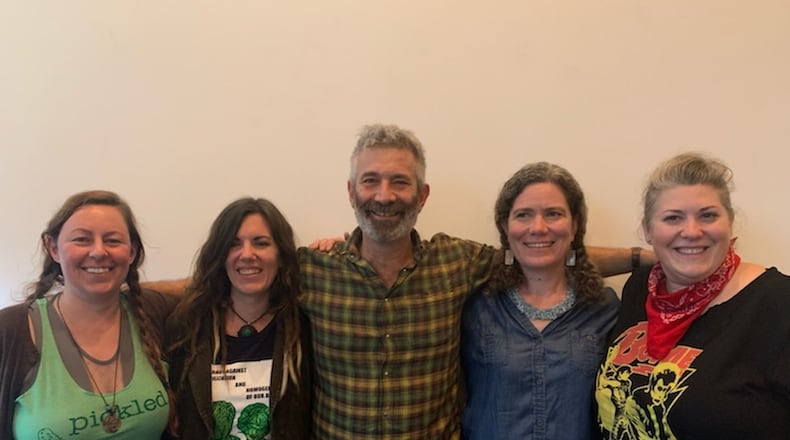Did I ever tell you about the time I killed my kefir?
It occurred a decade or so ago. My Bosnian friend Zemka had gifted me the kefir grains — the white globs that look like miniature cauliflower florets and have the texture of cottage cheese — needed to make the tangy, yogurt-like drink. The grains were given to Zemka by her friend, who lived in Canada, and who’d traced their origin halfway around the world to the country of Georgia. Precious stuff, people.
Kefir is now readily sold in the dairy section of most grocery stores. But, it wasn't back then. That's why some of us made it ourselves. Plus, it's easy to do — and cheap, too.
I nursed those gooey grains for a solid six months or more. As the culture grew, I divided the grains to keep them healthy and, like a good and generous kefir grower, gave some away to folks who I knew would be interested in a funky fermentation project.
At some point, I went on vacation, but forgot to hire a kefir babysitter. When I returned, my grains had dropped dead. No worries, I thought. I’ll just start over with a small cluster from what I’d given my friends. Wrong. They sheepishly admitted to not having been good kefir babysitters, either. Theirs, too, had keeled over from neglect.
My kefir adventures ended then, because I didn’t know anyone else with an interest in fermentation. I had no funky ferment community.
I do now.
Last month, I was one of about two dozen people who attended a two-day fermentation workshop in Atlanta that was organized by Julia Skinner, founder of food history and fermentation organization Root Kitchens. Skinner teaches classes about fermentation and food waste, including an online course called Preserving Abundance (find details at root-kitchens.com).
For the January workshop, Skinner rounded up some of the top fermentation experts from around the country. Presenters included Ferment Works founder Kirsten Shockey, Contraband Ferments community supported agriculture founder Cheryl Paswater (yes, a fermentation CSA really exists), fermentation coach Jillian Ross and — wait for it — Sandor Katz.
Sandor Katz!
Exclamation point explainer: Katz is the modern fermentation pioneer. I'm not sure when folks started calling him a "fermentation revivalist," but I do remember his groundbreaking "Wild Fermentation," published in 2003. The fermentation guru since has gone on to write other reference books on the topic, and his 2013 "The Art of Fermentation" even earned him a James Beard Foundation Book Award.
Fermentation has come a long way since Katz published “Wild Fermentation.” At the time, his DIY fermentation projects sounded so quirky. Now, lots of people are doing it.
Fermentation has gone mainstream for many reasons. From a health perspective, we know that fermented food is good for our gut. You’ve heard the word “probiotics,” right? Well, the foods that give your body beneficial probiotics are fermented. Live cultures are found in yogurt and sauerkraut, for example. It’s no wonder that those who focus on their diet for better health are into fermentation.
Second, umami is no longer a foreign word. We know that this fifth taste can be had in fermented foods, like miso, tempeh, nutritional yeast, kombucha, kimchi, soy sauce, olives, wine, beer, sprouted grains, beans and seeds, and so much more. Plus, DIY fermentation isn’t that hard. It doesn’t require expensive equipment, making it something that anyone — not just chefs — can mess around with.
Also, food waste is a national — indeed, global — topic of conversation. Fermentation can be part of that solution — and at little to no cost — as food scraps get one more use, their last bit of energy, nutrition and flavor extracted, before being tossed into the compost bin or turned into tea for plants.
We workshop attendees were there because we’re in awe of the science of fermentation — the chemical process by which food is exposed to bacteria and yeasts, which preserve it — and the endless possibilities it offers.
“Fermentation is only limited by our imaginations,” Skinner said when we spoke on the phone a few weeks after the event.
Like me, she geeked out to discussions about natto (the slimy, stinky Japanese food made from fermented soybeans, with a flavor profile similar to that of a nutty, aged cheese), and of the groundbreaking work that chefs Jeremy Umansky and Rich Shih are doing with koji, the microbe behind the umami flavors of soy sauce, miso and mirin. Umansky and Shih are even using it for vegetable charcuterie — curing plants like dry-aged meat. (Their forthcoming “Koji Alchemy: Rediscovering the Magic of Mold-Based Fermentation” will be released in May, and I cannot wait to crack open that guide.)
But, what most excited Skinner about that fermentation gathering was the gathering itself. “Herbalists, chefs, home cooks, farmers — all these people came and formed this little community,” she said.
Attendees came from as far away as California to get inspired by Paswater, who runs her fermentation CSA out of her tiny New York apartment, stashing her ferments in every inch of space — even under her bed. They also came to get inspired by Shockey, co-author with her husband, Christopher Shockey, of “Fermented Vegetables” and “Fiery Ferments,” and to hear about the fermentation operation they run in their Oregon homestead. They came to learn from Jillian Ross, aka the Ferment Lady, who lives a no-waste life in Florida.
Ross mentioned how she saves citrus peels, tossing them in vinegar and using it as a kitchen cleanser. She does the same to vegetable peels, using that as a flavored vinegar.
Both of those simple projects are now taking up space on my kitchen counter. I tasted the vegetable vinegar the other day. I like it. My husband doesn’t.
It reminds me of what Shockey told the workshop attendees: “If you like what you made, it doesn’t matter what anyone else thinks.”
Yeah, just like a decade ago, when I was the only one in my family who enjoyed drinking the kefir.
My kefir adventures ended because I didn’t know anyone else with an interest in fermentation. Now, I think I know a few people who would gift me some grains to get started again.
RELATED:
Read more stories like this by liking Atlanta Restaurant Scene on Facebook, following @ATLDiningNews on Twitter and @ajcdining on Instagram.
About the Author
Keep Reading
The Latest
Featured



